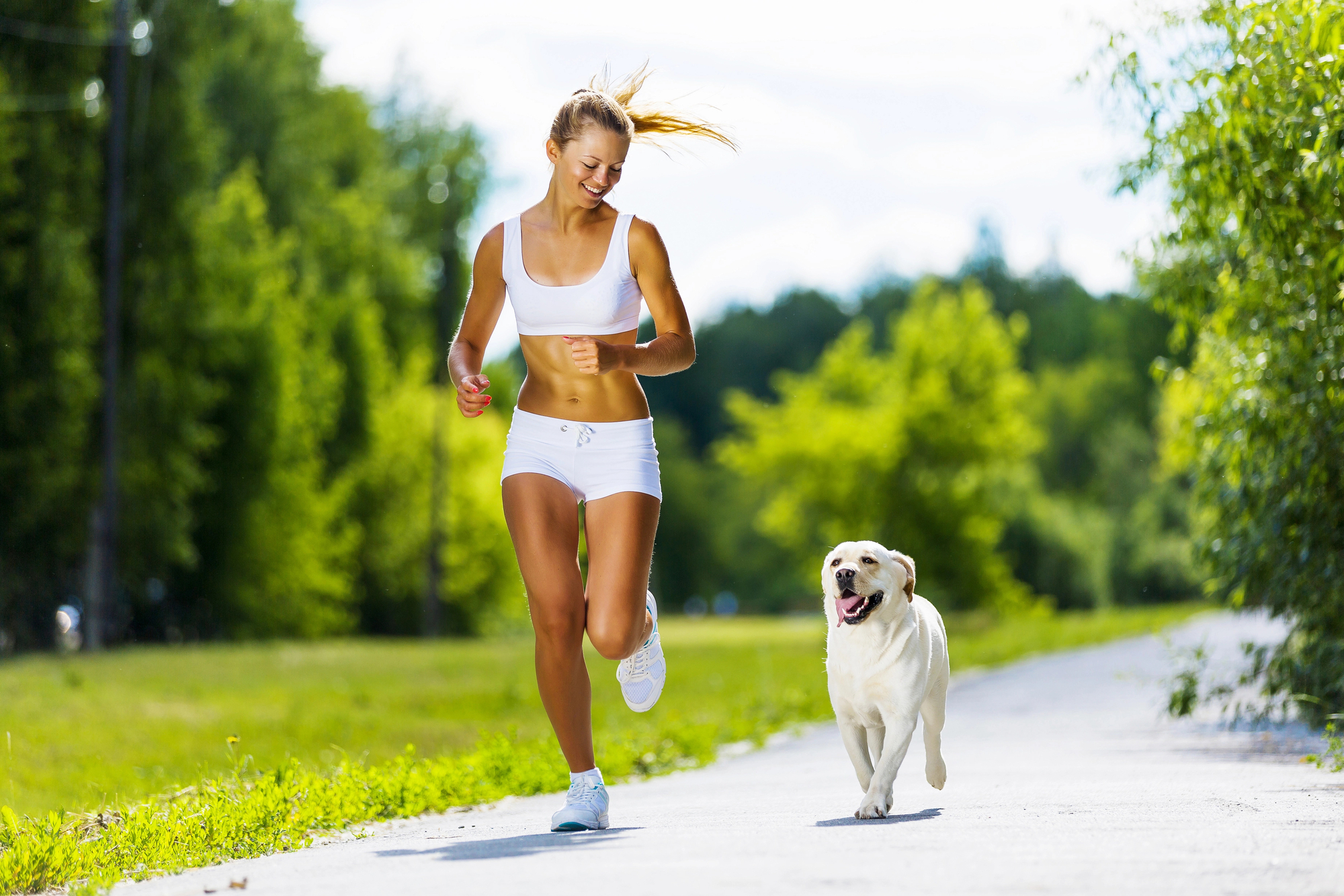
Imagine paws hitting the pavement in time with your favorite pair of sneakers as you run with your loyal canine companion by your side. Pet parents and their dogs often experience great joy and form a special connection when they exercise together. You both also gain many other benefits.
Running helps you and your dog manage weight, build muscles and improve cardiovascular health, which helps improve overall wellness. In addition to physical benefits, mental health benefits include reduced stress and increased bonding with your furry friend. Behavioral benefits include reducing your dog’s excess energy and improving its social skills, manners and obedience.
Combine your run with Halo Collar features to easily track your dog’s activity and promote safety by ensuring it remains by your side. This complete guide for safe and fun running with your dog includes tips to assess your pet’s health and make smart decisions for desired outcomes.
Preparing to Run With Your Dog
Before you hit the trails together, make some essential preparations to ensure your dog’s safety.
Assess Your Dog’s Health
Just as you’re advised to speak to your doctor before beginning a new exercise regimen, take your dog to its veterinarian for a checkup to ensure it’s physically fit for running long distances with you. Consider issues related to age and the breed that might require specific accommodations.
While there aren’t any hard-and-fast rules about how soon a puppy can start running with you, the consensus is to wait until the pup’s growth plates close. This timeframe varies by breed, with the average being 12 months. However, smaller dog breeds may reach plate fusion at 9 months, while larger or giant breeds may take up to 20 months. Until then, puppies can take walks up to about 5 minutes per month of age.
Conversely, senior dogs may not be able to join you due to aging joints or arthritis that may make running even shorter distances uncomfortable. You may also need to make special concessions for brachycephalic breeds such as boxers, pugs, bulldogs and other flat-faced dogs because they have unique breathing challenges that make exercising difficult.
Gear Up for Safe Running
Equipping yourself with the right gear improves safety. You can use a hands-free leash that clips to a running belt around your waist. However, you shouldn’t need one with appropriate training and a Halo Collar, an excellent tool for safety and keeping your furry companion by your side.
Reflective gear for you and your four-legged running partner improves visibility, ensuring drivers see both of you. Don’t forget poop bags to clean up after your pooch and water bottles for you and your dog to promote hydration.
Training Basics
Create a training plan that covers all the basics for your dog before you take it on the trail with you. Work on leash manners so your pet always walks politely beside you, on leash and off. Your dog must also know basic commands such as “slow,” “heel” and “stop.” These commands prevent trips and falls or being yanked around because your dog keeps switching positions or runs too fast. Positive reinforcement is essential for successful training.
Running Safely With Your Dog
Choosing the appropriate environment is essential to running with your dog safely. Start on soft surfaces to avoid joint stress. Stay away from hot pavement, especially in the summer, to prevent damage to your dog’s paw pads. You can protect your dog’s paws with canine booties, but ensure any shoes for dogs specifically say they prevent burns and blisters from hot pavement.
When timing your run, remember that some dog breeds aren’t suited for warm weather, and even those that are can still become overheated. Run with your dog during the cooler parts of the day, such as early morning and evening. Monitor your dog’s health for any sign of overheating, such as lethargy, excessive panting or drooling.
Related article: Which Dogs Are Best Suited for Warm Weather?
If you believe your pup is becoming too hot, immediately take it to a shaded area to rest. You can cool your dog down by rubbing its neck, belly and armpits with a damp towel or by pouring cool, but not cold, water over its body.
Related article: How to Cool a Dog Down: Summer Water Activities for Dogs
Hydration and breaks are crucial even on cooler days. Bring plenty of water and offer your dog frequent drinks during each break. Start with shorter runs or a combination of running and walking, then gradually build up how much exercise your pup gets. Slowly increase the distance and intensity as your dog’s stamina increases until it can handle longer runs. However, if your dog appears tired at any point, stop and rest. You should always check paw pads for injuries after each run.

Running Techniques and Tips
Maintaining your own pace is essential in controlling your dog’s pace on long runs. Except for short-legged canines, most dogs can outrun humans, so you must train them to run with you. Start slow and gradually increase speed, but keep a consistent pace. Use verbal cues to direct your dog to walk, run and stop.
While you want to start running with your dog on soft, even paths, your goal may be to graduate to running on different terrain. Trail running is popular, but you and your dog must be prepared for navigating impediments. You must watch for various obstacles and uneven terrain and adjust your pace and footing for different surfaces.
Additionally, be prepared to deal with distractions that snag your dog’s attention. Avoid areas with high animal traffic, and learn techniques to manage encounters with other dogs on leashes to minimize distractions. Even dogs that run for miles may suddenly be filled with boundless energy when they encounter something to play with, making it challenging to keep them on track. Be sure you’ve completed training for focus and recall before hitting the trails.
Post-Run Care and Considerations
Instead of stopping abruptly, thoroughly cool down for both you and your pet. Take some slow walks around a shaded area to let your dog’s heart rate decrease and its body temperature gradually cool. Find a place out of the heat to rest and offer your dog water once you feel you’ve walked enough to safely stop.
This rest break is an excellent time to check for injuries. Inspect your dog’s paw pads carefully. Also, check your dog’s legs and body for any signs of injury. If you notice anything unusual or your dog appears in pain, consult a vet.
Always allow ample rest after runs to ensure you and your dog enjoy regular exercise without overdoing it. Additionally, provide a balanced diet to support your pet’s active lifestyle. If you often run several miles together and your dog needs endurance, an ideal diet will be higher in protein and fat.
Common Questions and Challenges
How far/fast can I run with my dog?
How far and fast you can run with your dog depends on its breed, age, health and fitness level. Always start slow and gradually increase the distance and speed.
What if my dog pulls on the leash?
If your dog pulls on its leash, consider using a Halo Collar and positive leash training techniques. Halo Collars have a built-in training system to help support your efforts to teach leash manners.
How can I prevent my dog from chasing distractions?
Consistent focus and recall training are key. Stick to controlled spaces, such as your backyard, and avoid high-distraction areas until your dog is well-trained.
When should I seek advice from a veterinarian?
Consult a vet anytime you notice anything unusual about your dog, such as if it seems to be in pain or has drastically changed behavior.
Make Dog Running Safer and Smarter With Halo Collar
Running with your dog requires pre-run preparation and post-run care. Embrace the joy of this activity while prioritizing your dog’s well-being. The Halo Collar is a valuable tool for tracking activity and ensuring safety, giving you peace of mind. Check out the Halo Collar shop to learn more.
Dog running can be a wonderful experience. Share your adventures and photos on social media at #HaloCollar to inspire others to join in the fun.






